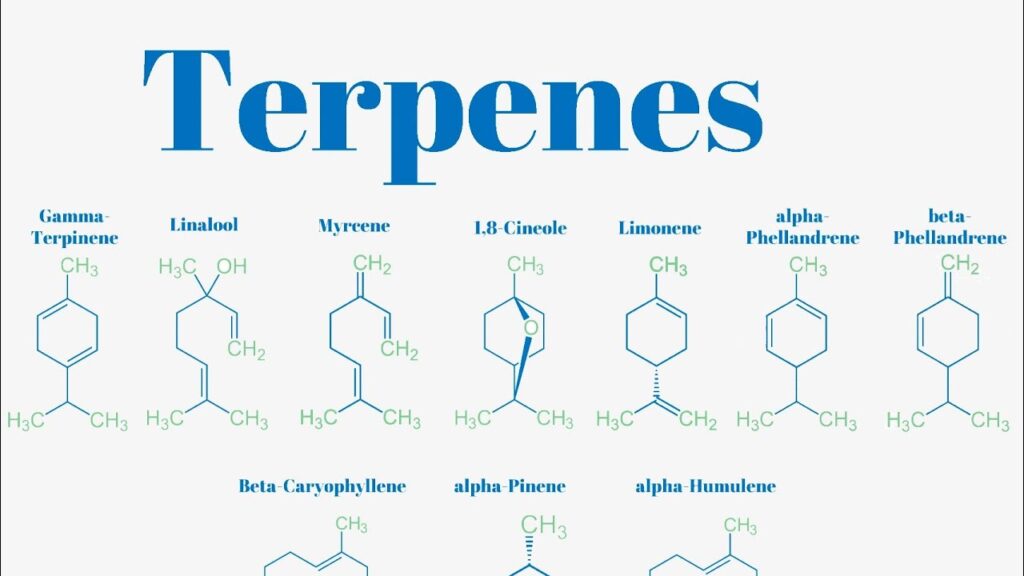What are Terpenes?


October 8, 2024
Terpenes are naturally occurring volatile compounds found in both plants and animals, and they play a vital role in our environment. You may not realize it, but terpenes surround you daily. They are responsible for the calming aroma of lavender, the fresh scent of a pine forest, and the unmistakable smell of freshly cut grass. In essence, terpenes contribute to the distinctive fragrances of various plants.

Terpenes are naturally occurring volatile compounds found in both plants and animals, and they play a vital role in our environment. You may not realize it, but terpenes surround you daily. They are responsible for the calming aroma of lavender, the fresh scent of a pine forest, and the unmistakable smell of freshly cut grass. In essence, terpenes contribute to the distinctive fragrances of various plants.
Chemically, terpenes are classified as aromatics due to their ring-like structures, which emit noticeable aromas. They are composed of isoprene units, with the basic molecular formula of (C5H8).
The classification of terpenes depends on the number of isoprene units they contain, which also influences their physical characteristics, such as boiling point, color, and smell.
Simpler terpenes, like monoterpenes (e.g., limonene and myrcene), have lower boiling points and tend to evaporate quickly. These compounds produce high notes in a fragrance profile. In contrast, more complex terpenes, often referred to as base notes, evaporate slowly, contributing to deeper, muskier scents but typically exist in smaller quantities.
This evaporation dynamic explains why certain aromas are more fleeting while others linger longer, creating a rich tapestry of scents in the natural world. Understanding terpenes not only enhances our appreciation of nature’s fragrances but also informs various applications in aromatherapy, perfumery, and even food and beverage flavoring.
If you examine your hemp flower closely, you’ll notice a crystalline, frost-like coating on the leaves and buds. This sticky substance, which carries the familiar scent of your strain, is made up of trichomes—the plant’s secretory glands. These tiny structures consist of a stalk topped with a mushroom-shaped head, which contains a rich resin filled with cannabinoids and terpenes.
The production of trichomes, and consequently terpenes, is significantly influenced by environmental factors, including nutrient and water uptake, temperature, humidity, airflow, and light spectrum. Optimizing these conditions can enhance trichome yield, leading to a greater concentration of the valuable terpenes and cannabinoids.
In nature, the production of trichomes serves a vital defense mechanism for flowering hemp. The bitter taste of the terpenes deters pests and animals from feeding on the plant. Beyond repelling larger herbivores, the aromatic resin also possesses antibacterial properties, protecting hemp foliage from harmful bacteria and fungi. Interestingly, terpenes also play a dual role by attracting beneficial pollinators, which help promote the plant’s reproductive success and overall population growth.
This complex interplay highlights the importance of terpenes in hemp cultivation—not just for the compounds themselves, but for their role in the plant’s health and ecological interactions. By enhancing trichome production through careful environmental management, growers can improve both the potency and resilience of their hemp crops.
Terpenes are crucial in defining the aroma and therapeutic properties of hemp. With over 100 identified terpene compounds produced in the trichomes, the aromatic profile varies significantly between strains. For instance, Durban Poison, a Sativa strain, exhibits a fruity and herbal aroma primarily due to terpenes like terpinolene, myrcene, and ocimene. While many other terpenes may be present, their smaller quantities often make their impact less noticeable. Nevertheless, even trace terpenes contribute to the overall scent, creating a unique aromatic profile.
Beyond their aromatic contributions, terpenes may also induce the “entourage effect,” a synergistic interaction with cannabinoids that enhances their medicinal properties. When inhaled, these compounds enter the bloodstream and interact with the endocannabinoid system (ECS), which plays a key role in maintaining homeostasis in the body. Cannabinoids help regulate functions like mood, sleep, and pain, while terpenes contribute their own medicinal qualities—such as anti-inflammatory effects and appetite regulation. This collaboration creates a unique therapeutic experience based on the specific combination of terpenes and cannabinoids present in a strain.
In the hemp industry, terpenes are valued for their dual roles: providing distinct aromas and potentially enhancing the medicinal benefits of hemp products. As the industry has expanded, various concentrates (such as distillate, wax, budder, and shatter) have emerged, often altering the original terpene content found in the raw flower. Factors like heat exposure, atmospheric conditions, and processing techniques (e.g., curing, extraction, and filtration) can lead to significant terpene loss.
For example, long exposure to heat during short-path distillation can result in oils that lack recognizable terpene profiles. Since terpenes are volatile and tend to evaporate at temperatures below 150°C (302°F), they are often lost before cannabinoids are fully distilled. Consequently, if terpenes are collected during distillation, they may have degraded into undesirable compounds or become contaminated with residual solvents, making them unsuitable for reintroduction.
Terpenes are typically extracted using methods like steam distillation, where plant material is suspended over boiling water, allowing steam to carry the volatile compounds into a collection flask. However, this process can lead to the loss of sensitive terpenes, particularly those present in small concentrations. Additionally, variations in terpene profiles can occur due to differences in genetics and processing methods.
For cost-effectiveness, many processors turn to botanical-derived terpenes, such as limonene from citrus fruits, which share therapeutic properties with those found in hemp. While this can be a viable alternative, it complicates efforts to replicate the unique terpene profiles of specific hemp strains.
As the hemp industry continues to grow, advancements in technology and extraction methods will be essential for maximizing terpene retention and creating consistent profiles. Whether aiming to mimic existing strains or develop unique blends, experimentation and innovation remain at the forefront of this evolving field.